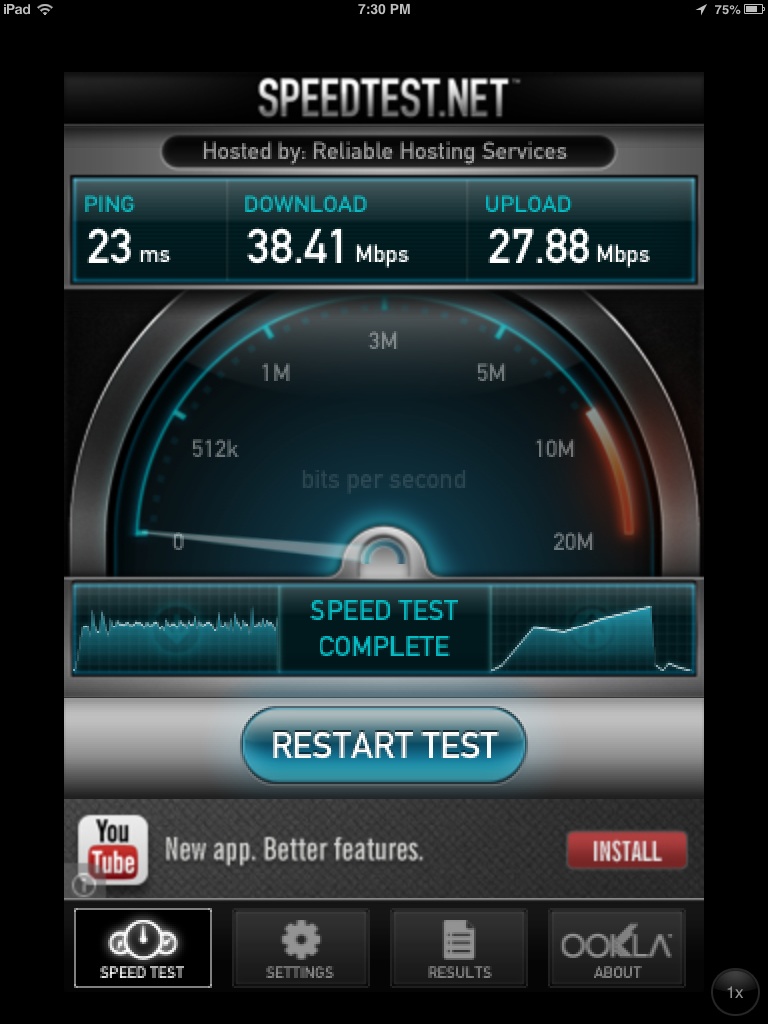RJM62
Touchdown! Greaser!
- Joined
- Jun 15, 2007
- Messages
- 13,157
- Location
- Upstate New York
- Display Name
Display name:
Geek on the Hill
My little village of < 600 residents has its own local phone company, which also provides cable TV and Internet (and I believe fiber soon).
My little phone company provides very dependable service. Outages are few and very quickly repaired. They also have real "tech guys" who are honest-to-goodness Americans who hang out at an office within walking distance, and real people who answer the phone when you call. And if you want to make a payment in person or by phone, they ask for your name, not your account number. It's kind of surreal for someone like me who was raised in The City.
Anyway, I've had an old D-Link wireless router (old as in draft N -- so it owes me nothing) uttering gasps of impending death lately, so I replaced it today. After I was done configuring the new router, I did an Internet speed test.
My tested speed was 23.71 Mb/s down and 1.61 Mb/s up -- and that was on a Windows machine (Linux usually tests a bit faster), with some other machines (including the TurtleCam video server) on the LAN using up some bandwidth.
My connection is a "business-class" cable connection that costs me, I believe, $75.00/month. It has a 750 G/month cap, but I've never come close to hitting it; and all they do if you hit it for a few consecutive months is call you up and let you know you need to buy more bandwidth. They don't throttle you or even charge for the overage unless you're consistently over your limit and refuse to upgrade.
The good customer service I've come to expect from rural businesses. But it's amusing to me that the fastest copper Internet service I've ever had is in a tiny village in the middle of nowhere.
-Rich
My little phone company provides very dependable service. Outages are few and very quickly repaired. They also have real "tech guys" who are honest-to-goodness Americans who hang out at an office within walking distance, and real people who answer the phone when you call. And if you want to make a payment in person or by phone, they ask for your name, not your account number. It's kind of surreal for someone like me who was raised in The City.
Anyway, I've had an old D-Link wireless router (old as in draft N -- so it owes me nothing) uttering gasps of impending death lately, so I replaced it today. After I was done configuring the new router, I did an Internet speed test.
My tested speed was 23.71 Mb/s down and 1.61 Mb/s up -- and that was on a Windows machine (Linux usually tests a bit faster), with some other machines (including the TurtleCam video server) on the LAN using up some bandwidth.
My connection is a "business-class" cable connection that costs me, I believe, $75.00/month. It has a 750 G/month cap, but I've never come close to hitting it; and all they do if you hit it for a few consecutive months is call you up and let you know you need to buy more bandwidth. They don't throttle you or even charge for the overage unless you're consistently over your limit and refuse to upgrade.
The good customer service I've come to expect from rural businesses. But it's amusing to me that the fastest copper Internet service I've ever had is in a tiny village in the middle of nowhere.
-Rich
Attachments
Last edited:


